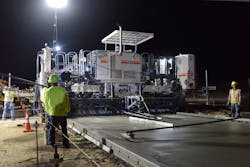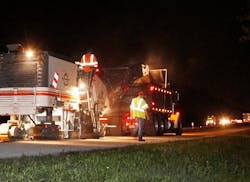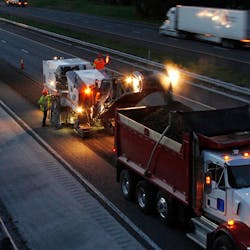Nighttime Road Paving Poses Challenges in the Dark
There are a number of reasons to stage asphalt paving and milling operations at night, including less traffic for crews to contend with, less inconvenience to road users, and tight project deadlines that require going beyond daytime-only work.
But with nighttime paving operations come unique safety concerns: setting up the work zone with best practices, selecting lighting for vision and safety, and in general, knowing what to do differently for nighttime versus daytime road paving operations.
“Nighttime paving is growing in prevalence,” says Dale Starry, global trainer for compaction at Volvo Construction Equipment. “It can be challenging in that it’s harder to see—and to be seen.”
How intelligent compaction brings safety to road paving operations.
Starry says that most agencies realize that paving at night can help to reduce traffic congestion and delays. “They acknowledge that safety of the crew and traveling public can be more difficult in reduced lighting conditions, however, and adopt specifications for night work that include specific work zone safety regulations,” he says.
Work zone best practices
The Federal Highway Administration has published a Work Zone Best Practices Guidebook that Starry often cites in his presentations. “This reference incorporates many positive examples of how to work at night, assembled from individual state and provincial specifications,” he says.
Starry singles out some key excerpts: NJDOT, Nighttime Lighting Specification for Night Work; NYDOT, Nighttime Construction Operations; NCDOT, Portable Lighting Specified in Contracts Containing Critical Lane Closures and/or Merges; ODOT, Certified Worksite Traffic Control.
“The online version has links to each cited specification for access,” Starry says. “Managers should make it a point to follow-up and read through all of them the next time they have an opportunity to go online.”
There are even more resources available. “There’s an excellent interactive training program that’s been developed in cooperation by the American Road and Transportation Builders Association Transportation Development Foundation, the National Asphalt Pavement Association, and the Texas Transportation Institute,” Starry says. “There are multiple courses specifically developed for roadway safety at night, including OSHA 10-hour accredited training sessions.”
As the work zone is being set up with best practices, it’s important to keep in mind the special human challenges inherent with night work. “Quite simply, night operations change the work environment,” Starry says. “On the worksite, there can be poor visibility for motorists and workers, [difficulty in] communication between shifts, and the possibility of impaired or drowsy drivers. Also, the amount of light a motorist requires [to see] at nighttime doubles every 13 years [as you age].”
Just as motorists have to adjust, so do road workers. “There are also physical and social disruptions for workers, including sleep disruption, risk of injury from drowsiness, and impaired family or social relationships,” according to Starry.
“We have to consider the effect of night work on our health,” Starry says. “Night work is not normal and requires us to compensate for the change in routine by eating protein-rich foods and avoiding sugars and fats. Similarly we need to drink extra fluids but avoid caffeine and alcohol.
“Getting plenty of sleep is important, especially since our bodies are conditioned to being alert during daylight hours,” Starry says. “Lack of sleep is always dangerous as it can lead to reduced awareness and slower cognition.
“On the worksite, eat those protein-rich meals, avoid sugars and fats, drink water, and avoid caffeine,” Starry says. “At home, make sleep a priority, follow a pre-sleep routine, have a light snack before bed, keep daylight out, eat family meals together, and plan daytime social activities.”
Job site lighting
Before considering lighting on a project, it’s helpful to know some basic definitions that Starry uses in his training. They are related to common specifications: lumens, foot-candles and lux, candlepower, and brightness.
Lumen is the unit of total light output from a light source. If a lamp or fixture were surrounded by a transparent bubble, the total rate of light flow through the bubble is measured in lumens. Lumens indicate a rate of energy flow. Thus, it’s a power unit, like the watt or horsepower.
Foot-candles and lux are units that indicate the density of light that falls on a surface. This is what light meters measure. Foot-candles or lux are used to measure the adequacy of lighting on the task. Foot-candles and lux relate only to the task area, not to the lighting equipment or to the geometry of the space.
Candlepower is a measure of lighting concentration in a light beam. It is used primarily with lamps that focus, such as spotlights and PAR lamps. In lamps where candlepower is specified, the candlepower rating usually applies only to a small spot in the center of the beam.
“This is a measure of lighting in a light beam, used primarily with spotlights and other lamps that focus their light for a particular distance,” Starry says.
In general, brightness is an expression of the amount of light emitted from a surface per unit of area. “‘Brightness’ is not an official term of the lighting trade; however, the concept is essential for understanding visual quality, especially in relation to contrast and glare.
“It is not a technical term but is used by laypersons to quantify the amount of light emitted from a light source,” Starry says. “We typically understand the concept that a 100-watt incandescent light bulb is brighter than a 60-watt bulb.”
Starry says there are generally three levels of lighting needed for safe work on nighttime paving projects. They are: Level 1, general site lighting for workers on foot, 60 lux; Level 2, lighting for working near equipment so quality control personnel can monitor pavement mats closely, 110 lux; and Level 3, lighting at stations for traffic control personnel, 220 lux.
“Each is distinctly assigned on the basis of application and relative risk to the workers involved,” Starry says. “We can achieve these varying levels of lighting using a number of different lighting technologies. Many of the traditional lighting types such as incandescent and fluorescent are being replaced by newer technologies. These include halogen, High-intensity Discharge (HID) and Light Emitting Diodes (LED).
“So that you understand that lighting levels are not absolute, I’ll cite another lighting specification that I discovered during my research,” Starry says. “The Nova Scotia Highway Department prepared lighting specifications for a night project on Highway 125 near Sydney. Their levels of lighting were established at three levels.Level 1 lighting at 60 lux was specified for general site lighting to provide safety for workers on foot.
“In order to accomplish this level of illumination, the contractor placed portable light towers along the project route,” Starry says. “These light sources was spaced at regular intervals based on testing done to measure illumination along the route. So even in an urban environment where permanent lighting fixtures are installed adjacent to the roadway, it’s often necessary to add portable lighting to augment the illumination levels to meet agency specifications.”
Not only is the position of lighting important, but so is the position of workers. “Remember that traffic control personnel also need to pay attention to where they are standing,” Starry says. “Incorrectly positioned, the worker may actually be obscured by the intense illumination of the lighting source. This can increase risk of being struck by traffic compared with being correctly positioned relative to the source of illumination.”
Personal protective equipment
Workers need to take special precautions at night.
“They need to be seen,”says Bob Madson, a paving specialist from Altorfer Cat. “In Iowa, the workers even have to wear reflective leg apparel. I believe it helps; as you walk, it draws attention to that person. And, the farther away and the slower the traffic, the better—having a police car on the job keeps traffic slowed and alert.”
Starry also talks about clothing. “Increase your visibility by wearing retro-reflective clothing,” he says. “Flashing lights also draw attention. Retro-reflective tape on equipment is also a good idea. And don’t underestimate the importance of knowing your surroundings. Being aware of the work zone can help keep you safer.”
Starry recommends bright safety vests/clothing with reflective stripes, including jackets, pants, and vests.
“Even in poorly lit conditions, reflective striping can be seen,” he says. “Silver trim seems to provide the greatest degree of reflectivity. Cuffs on jackets and pants, trim on vests, and bands on hats or helmets work together to enhance visibility.
“Put yourself in the motorist’s seat, behind the wheel of a vehicle traveling at the relatively modest speed of just under 45 miles per hour,” Starry says “Even young eyes would have difficulty seeing a person wearing dark clothing until approximately 100 feet away. Adding the traditional orange safety vest really does not improve our ability to see a pedestrian, but changing to white clothing increases our decision and maneuver distance to just under 300 feet or 100 yards—the length of a football field. Adding reflective accessories more than doubles this distance.”
David Murray, safety and health consultant for the State of Nevada, further details the safety garments for workers. “For (nighttime) workers, Type 3 garments are mandatory,” Murray says. “Type 3 requires 360-degree visibility. These include refelective material on sleeves and shirts, reflective bands around the arm, either in long sleeve or short sleeve. Jackets need to have reflective material bands around the arms and jacket body.”
To put the levels in context, Murray adds that police require a Type 1 garment to direct traffic, and workers in the daytime need a Type 2 garment, usually a reflective vest. Reflective materials on equipment also help motorists see operations at night. Remember that every paving project has more-or-less continuous truck traffic delivering mix to the paving spread.
“The key to nighttime paving operations, in my personal opinion, is to work ‘smart,’” Starry says. “In the real world, an agency and a contractor have a few common objectives but a few dissimilar ones, too. The agency is interested in compliance with its regulations, specifications, and work plans, but is not always focused on production.
“On the other hand, the contractor is always focused on production; this determines whether or not a profit is realized after a project is completed,” Starry says. “Compliance with regulations and specifications is also an important consideration, but does not always directly impact the financial aspects of the work being done, except for the incentive and/or disincentive pay elements, if they exist.”
A balance must be struck, with both parties being aware of the risks and the regulations.
“In general, nighttime paving applications require our workers to be in proximity to both heavy equipment and traffic,” Starry says. “The environment can be dangerous for the inexperienced. Working around milling, paving, and compaction equipment always requires being alert and careful. A key is training—you can never give or receive enough.”







